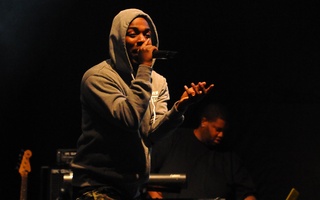If you have attended any race-related protest or rally last semester, you may have noticed that Kendrick Lamar’s “Alright” has become something of the rallying cry du jour. Just before Spring Break, the Harvard Hip Hop Archives inducted Kendrick's album “To Pimp a Butterfly” into its Hall of Fame. Black Lives Matter protests and campus solidarity marches alike have been fueled by the triumphant declaration of eventual salvation. Watching crowds of emotionally overwhelmed college students come together in the haze of Lamar’s words during Harvard’s solidarity march with Tufts truly touched me. But even so, it makes me wonder if we may have missed some of Kendrick’s larger message by using the song in this way.
The power of the song cannot be ignored. From the opening bars, an enchanting beat lures the listener, leaving no hope of escape. Kendrick weaves a narrative of pain and suffering with the distinct potential outcome that salvation may indeed come. The song radiates a type of hope that acknowledges a long history of degradation and marginalization by the powers that be. This potent combination makes “Alright” one of the best-suited popular songs to double as the protest anthem of our time, especially considering growing tensions between the black community and law enforcement across the country.
Despite the uplifting message in “Alright," “To Pimp a Butterfly” has a much darker tint on the whole. Much of the album not only takes a critical look at injustice in America with a somewhat defeatist slant, but it also displays Kendrick’s brutally honest introspection. In "u,” Kendrick mercilessly turns the mirror on himself as he rips apart the layers of his pathology related to his struggles with fame in particular. While this darkness gives birth to “Alright,” it also gives the entire project a purposefully dark air.
Though “Alright” may successfully unify and energize a larger movement, I wonder if removing it from the context of the album denotes shortcomings in the current movement. I do not say this to argue that protesters should look for another hook to chant as they assemble, but rather that they must introduce a similarly dark, complex context to the protest movement that “To Pimp a Butterfly” gives its songs.
As of now, the Black Lives Matter movement on campuses across the country and beyond seems more like a cathartic experience than an agent of political or social change. Yes, some isolated instances of protest have seen greater tangible progress than most. The students at the University of Missouri, for example, managed to oust their President, but this came only after the financial impact of a threatened football game forfeit and other extenuating factors came into play. General student protests alone have produced little tangible results beyond discord and emotional release.
Catharsis, to be clear, is a perfectly valid reason for peaceful assembly. Personally, I fully empathize with the minority college student that feels a need to release some tension caused by the constant reminder of your minority status in a predominately white institution. But if we want to precipitate real change, we must take the affirmative steps necessary to do so. Change will not come without organization outside of the college campus and beyond the protest space. This does not mean students should stop protesting, but rather that students should understand the real macro impact, or lack thereof, of what they are doing.
To this point, the protest movement seems to lack the level of self-awareness and internal critique that Kendrick possesses. “Alright” would not have the same inspirational power if it came without “u”. I can only speak directly about the black community, where I see a real problem. Pointedly parsing out weaknesses and faults of the movement, such as the uneven public representation of women and the LGBT community, only makes it stronger in the long run, but this has been largely absent from much of the internal campus protest dialogue. While no one should lose track of the larger goal at hand, taking time to complicate and interrogate the internal shortcomings of the movement by the activists themselves allows for a self-realization of a larger end of equality.
Jaime A. Cobham ’17, a Crimson editorial writer, is a government concentrator in Mather House. His column appears on alternate Tuesdays.
Read more in Opinion
Thank God for Donald TrumpRecommended Articles
-
Like a Rolling StoneCareer plans have never been something I worry about very much. When I was in high school, I never thought
-
Boston Joins Nation in WTO ProtestMore than 30 Harvard students joined hundreds of Bostonians who gathered downtown to protest the World Trade Organization (WTO) and
-
 Hear Me Out: Kendrick Lamar, 'i'
Hear Me Out: Kendrick Lamar, 'i' -
 “To Pimp A Butterfly” A Provocative and Ground-Breaking Collage
“To Pimp A Butterfly” A Provocative and Ground-Breaking Collage -
 Untitled Unmastered
Untitled Unmastered













